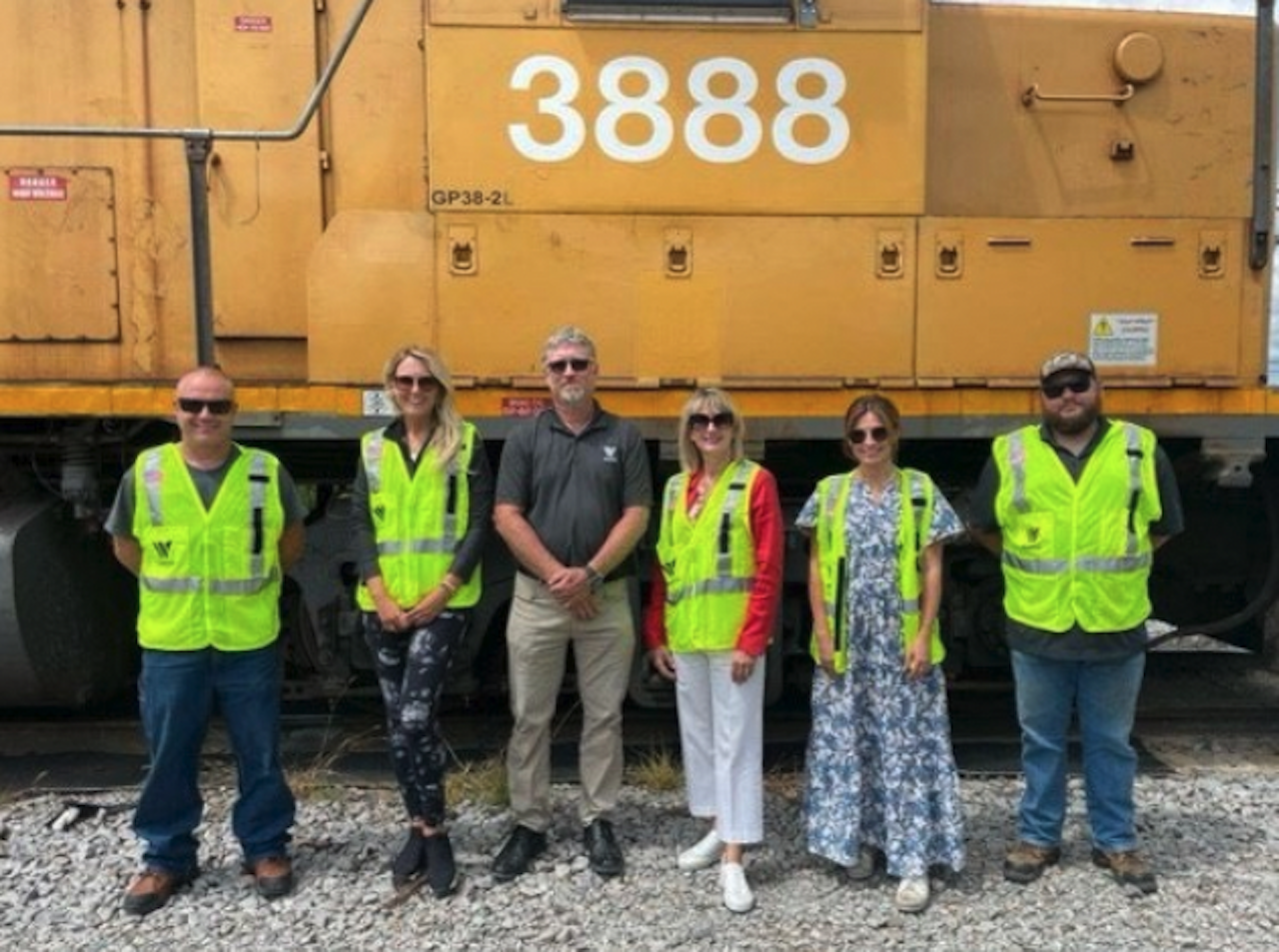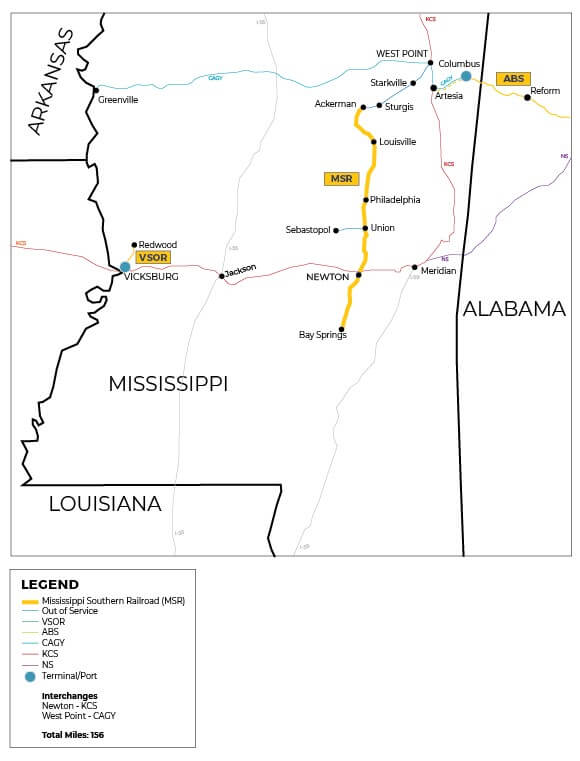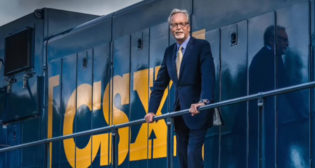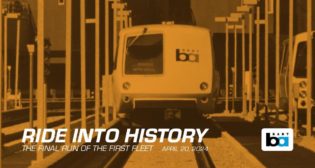
Small-Road Briefs: Mississippi Southern Railroad, FRA
Written by Carolina Worrell, Senior Editor
Anna May (second from right), a staff member from the office of Congressman Michael Guest (R-Miss.), and Missy Younger (third from right), a staff member from the office of Congressman Trent Kelly (RMiss.), joined Watco Assistant Vice President-Government Relations Ailsa von Dobeneck (second from left) for a tour of ASLRRA member and Watco company Mississippi Southern Railroad and a discussion of short line freight rail industry priorities.
Mississippi congressional staffers tour Watco-owned Mississippi Southern Railroad (MSR). Also, the Federal Railroad Administration (FRA) could be opening the 2022 Consolidated Rail Infrastructure and Safety Improvements (CRISI) grant program soon and is continuing its Office Hours webinars to discuss Railroad Crossing Elimination (RCE) grant program.
Mississippi Southern Railroad
Anna May from the office of Congressman Michael Guest (R-Miss.) and Missy Younger from the office of Congressman Trent Kelly (R-Miss.) visited American Short Line and Regional Association (ASLRRA) member MSR last week, ASLRRA reported in its latest newsletter.
May and Younger joined Ailsa von Dobeneck, Assistant Vice President-Government Relations of MSR parent company Watco, for a tour of the rail facility and a discussion of short line legislative priorities. Von Dobeneck gave the staffers a general overview of the short line freight rail industry and fielded several questions regarding infrastructure investments and the CRISI grant program.

Visits like these, ASLRRA says, are “an important way to make connections with lawmakers and help them understand more about the short line industry and the effects of federal legislation on railroad operations.” ASLRRA adds that summer, when many lawmakers are in their hometowns while Congress is in recess, is a good time to reach out to representatives.
FRA CRISI Grant Program
According to ASLRRA, the latest news indicates that the FRA could be opening the 2022 Consolidated Rail Infrastructure and Safety Improvements (CRISI) grant program “as soon as this week.” In anticipation of the release of the notice of funding opportunity (NOFO), ASLRRA revisits its Preparing for CRISI series with information provided by Blank Rome Government Relations Senior Advisor Richard Sherman in its latest newsletter and presents the steps railroads can begin taking to prepare their grant applications.

CRISI Steps One Through Five–From Registering Your Railroad to Using FRA’s Templates:
Before pursuing funding through CRISI, the applying entity must be properly registered in two federal systems: The System for Award Management (SAM) and grants.gov. Grant applicants must first be set up in SAM to register in grants.gov and all recipients of federal funds must be registered in SAM. All application materials are submitted through grants.gov.
Two: Prepare Foundational Documents
The FRA requests that applicant provide three foundational documents as attachments: a project statement of work (SOW), a schedule and a budget. It is not uncommon that the FRA receives CRISI applications in which these documents are incomplete or do not fully agree with one another, the narrative or other parts of the application. Completing these three documents at the beginning of the grant writing process reduces the risk of this problem, and having the documents early assists with preparation of other application elements
Three: Communicate the Transportation Analysis
Effective communication of the transportation analysis supporting a CRISI application is fundamental to making the case for the project. Most CRISI applications will have a forecast for traffic of some type, often in the form of revenue carloads transported over twenty years, sometimes more, from the expected completion of construction. It is surprisingly easy to provide an excellent data-driven transportation and benefit-cost analysis in the application attachments but neglect to communicate that information well in the grant application narrative. The narrative document must bring forward all important data and findings, including at least summary versions of traffic forecasts and scenarios.
Four: Coordinate with Partners
Some short line projects seeking federal CRISI funds will involve getting the permission of outside parties, so identifying and working on these tasks early in the grant application writing process is important. A common scenario for short lines is when a major Class I freight railroad must approve the proposed grant-funded project. Short lines should review their lease agreements closely because leases can include clauses specific to pursuit and use of public grant funding. Short lines should also presume that Class I permission will be required if the proposed project could affect the Class I’s property or operations. The fact that a Class I won’t contribute any monetary resources to the proposed CRISI-grant-funded project does not eliminate the need to meet all their legal and operational coordination requirements.
FRA guidance directs grant applicants to templates for three required attachments for their capital grant programs: the statement of work (SOW), schedule, and budget. These templates have sometimes been confusing to CRISI applicants because they are provided in the form of drafts of what will become the starting point for attachments to a formal federal grant agreement if the application is successful. Nevertheless, applicants should use these templates as requested by FRA, ideally without modifying the language and structure of the documents as provided. Rather, applicants should seek to insert the requested data where indicated, and as indicated.
FRA RCE Grant Program
Separately, ASLRRA announced in its recent newsletter that the FRA Office Hours webinars will continue this week with a discussion of the SOW document that must be submitted with grant applications.
In response to a high level of interest in the RCE grant program, the FRA is holding Office Hours webinars every Thursday through Sept. 8, focusing on a different aspect of the NOFO during each session. While these webinars are focused on RCE grants, ASLRRA says, the information discussed could be insightful for railroads planning to apply for other grants, like the CRISI program.
Click the links below to register for the FRA’s remaining Office Hours sessions. Each webinar requires a separate registration.
- Sept. 1: National Environmental Policy Act (NEPA) and environmental considerations
- Sept. 8: NOFO “nuts and bolts” (e.g., grants.gov, SAM registration, and other required elements)
The FRA has also made recordings of its previous Office Hours webinars available online, along with a recording of the original RCE grant program NOFO webinar. These earlier webinars, ASLRRA says, discuss the project narrative and applicant eligibility, project type and life cycle. Find these resources at the FRA’s Training and Guidance Webinars page under the Grants and Loans tab.



